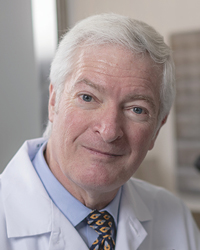Looking beyond opioids

A new Center for Pain Therapeutics and Addiction Research will position the school as a multidisciplinary leader revolutionizing pain treatment and addiction management
By Jessica Binkley Lain
Pain management is not a new challenge for dentists. Teeth are composed of some of the most highly innervated tissues in the body, and the mouth is a region vulnerable to infection, so dentists must often contend with extreme patient pain during treatment.

“Dentists have become, by necessity, experts in terms of diagnosing and treating inflammatory pain, so there’s a long history in the discipline,” said Kenneth Hargreaves, DDS, PhD, professor of endodontics and a world-renowned expert in pain research. “To that end, the School of Dentistry has been advancing pain research to improve pain management for over 20 years.”
In an innovative move to put the School of Dentistry’s research efforts on the global stage, the school recently launched its Center for Pain Therapeutics and Addiction Research, appointing Hargreaves to serve as the center’s inaugural director in August 2024.
The new center brings together experts across disciplines to increase the understanding of the basic mechanisms of pain, as well as to shed light on addiction.
“The University of Texas Health Science Center at San Antonio has long been recognized internationally for its groundbreaking work in addiction and substance use disorder,” Hargreaves noted. “We see this new center as a complement to this established expertise of the university and a natural progression of all the research and training efforts our school has been involved in over the years.” The center has members from multiple departments within the dental school and is actively recruiting faculty from across the university. The center already hosts two members from the Joe R. and Teresa Lozano Long School of Medicine’s Department of Pharmacology, signaling its interdisciplinary and collaborative approach to pain and addiction research.
A major focus of the center is basic science research that will lead to the development of novel, non-opioid analgesics.
Currently, explorations into pain caused from specific conditions, such as temporomandibular joint disorders and oral cancer, aim to understand the underlying mechanisms that contribute to pain and to discover potential targets for future drug development.
Targets for oral cancer pain

“When people think about cancer, they often think of chemotherapy or the disease progression, but cancer pain is its own unique challenge that needs more attention in cancer and pain research,” said Shivani Ruparel, PhD, associate professor in the Department of Endodontics.
Ruparel has focused her research career on oral cancer, which she described as being particularly painful. Unlike other cancers such as breast or prostate cancer, which typically only cause pain when metastasized to the bone, oral cancer induces pain as soon as the tumor begins to grow, even when it is small, she explained.
“Patients with oral cancer experience pain from the start, and unfortunately, the main treatment option is opioids,” she said.
This opioid reliance, she noted, presents several issues. Oral cancer patients often develop tolerance to opioids quickly, and there is evidence that opioids can promote cancer progression.
“It’s a devastating cycle. Not only do these patients endure pain, but their pain treatments may also be worsening their condition,” Ruparel said.
Oral cancer is the sixth most common cancer globally, affecting 400,000 to 600,000 people annually. However, it receives less attention and research funding than cancers like breast and prostate cancer. Moreover, treatment options for oral cancer are successful in only about 50% of cases, Ruparel said.
“These patients are suffering a lot of pain, so we need more research in pain management for these patients, especially into non-opioid treatments,” said Ruparel.
She studies how tumors interact with sensory nerves, focusing on where the pain is produced at the site of the tumor. Her team is particularly interested in a protein called brain-derived neurotrophic factor, or BDNF, and its receptor, TrkB — both of which are highly expressed in oral tumors.
“We discovered that targeting BDNF and TrkB not only slows tumor progression but also reduces pain,” Ruparel explained. “This is a hugestep forward because it means we can potentially treat the cancer and the pain simultaneously.”
Ruparel is excited about the new center, particularly for its promise for discovering non-opioid solutions to pain.
“The opioid crisis has made treating chronic pain even more complex,” she noted. “This center is a significant step forward, not just for the School of Dentistry and the university, but for the global pain research community.”

Potential of stem cells
Stem cells are another exciting area of research, with a potential for non-opioid analgesic drug development. Among the scientists driving this progress is Nikita Ruparel, MS, DDS, PhD, associate professor and sister to Shivani Ruparel in the Department of Endodontics, and a researcher at the new center. Nikita Ruparel and her team are researching the mechanisms by which stem cells can inhibit oral facial pain.
“Having worked on tissue regeneration with stem cells as a postdoc, I had a great understanding of how stem cells function and what their capabilities are as a therapeutic class,” Nikita Ruparel explained. “So, I asked myself, if stem cells are so powerful in modulating the immune response and providing regeneration, why don’t we have more literature on their effects on pain management?”
This curiosity led Nikita Ruparel to explore the use of stem cells in treating dental pain, specifically in a condition called apical periodontitis, a common inflammatory disease caused by tooth infection.
By injecting human stem cells into mice with the condition, she and her team found that the pain thresholds in the mice returned to normal following the stem cell injections. This was an exciting discovery, showing that stem cells could significantly impact pain responses, said Nikita Ruparel.
By injecting stem cells into the mouse models, the team was able to observe a complete reversal of pain after 21 days. The tests included assessing sensitivity around the affected area of the mouse’s face, as well as tracking the spontaneous pain response through behavioral experiments.
“We found that stem cells actually migrate directly to the site of tooth injury,” Nikita Ruparel revealed. This homing mechanism, known as chemotaxis, allows the stem cells to move toward injured tissues that release specific factors, drawing them in. Once there, the stem cells not only aid in tissue repair, but also inhibit pain.
“The factor SDF-1, or stromal-derived factor 1, is six times more present at an injured site compared to healthy tissue,” Nikita Ruparel. explained. “Stem cells are drawn to these elevated levels of SDF-1, which is why they go directly to the site of injury. This response is something we can mimic without needing to inject stem cells.”
One of the factors stem cells release is called macrophage migration inhibitory factor, or MMIF, which inhibits pain neurons, said Nikita Ruparel.
“Our ultimate goal is to take the receptors for MMIF that are present on sensory neurons and use them as drug targets in patients. Instead of injecting stem cells directly into humans, we’re working to create drugs that replicate the effects of the stem cell-released factors to alleviate pain.”
The center also promises to provide students with unparalleled opportunities.
“Having this center will help our students get a more comprehensive experience,” Nikita Ruparel said. “Other scientists within the university will recognize its potential, and we can create a more collaborative environment for mentoring the next generation of pain researchers.”
Simple diet changes
Other investigations at the new center are focused on how the role of secondary factors influence the risk of overall pain throughout the body.
“One of the center’s investigators is looking at the role of hypoxia in pain,” Hargreaves explained, referring to research by Nathaniel Jeske, PhD, director of research for the Department of Oral and Maxillofacial Surgery, who recently published a paper showing that sleep apnea could increase the risk of pain.
“We’re even investigating the role of diet in pain management, exploring how dietary changes, rather than drugs, might influence the development of pain,” Hargreaves said.
For nearly 15 years, Hargreaves and a team of researchers have been studying two classes of lipids — omega-3 and omega-6 — and their role in reducing or increasing the risk of pain in the body.
“You’ve probably heard of the Mediterranean diet, which emphasizes healthy omega-3 lipids and is widely recognized not only for helping with weight loss, but also for promoting heart health and improving metabolic function,” Hargreaves said. “What we’ve discovered is that omega-3 can also help relieve pain. On the other hand, the other class of lipids, omega-6 lipids, we found to be pro-inflammatory. These lipids are found in fried foods, and when your body is filled with omega-6 lipids, it actually leads to a greater pain response after an injury.”
In laboratory studies with diabetic mouse models, Hargreaves and his team found that feeding them a diet heavy in omega-6 lipids made their diabetic pain much worse. However, when fed a healthy omega-3 lipids diet, their diabetic neuropathy was nearly reversed — just by changing their diet.
Recently, Hargreaves received a $1.3 million grant from the U.S. Department of Defense to evaluate the role of omega-3 lipids in treating diabetic pain and second-degree burn injuries.
“If we can treat these conditions with simple dietary changes, taking a nutraceutical approach instead of a pharmaceutical approach, not only can we improve patients’ quality of life, but we can also avoid the use of opioids,” he said.
Training and policy
In addition to research, education also plays a crucial role in the new center’s mission. Dentists at the predoctoral and graduate levels are being trained in the latest methods for diagnosing and treating pain.
“Our goal is to help dentists counsel patients who might show signs of substance use disorder, providing appropriate referrals to experts for better care,” said Hargreaves. Shaping policy is another goal of the center, particularly around the responsible prescription of opioids.
“The dental school has been at the forefront of developing policies for when and under what conditions to prescribe opioids. While opioids are an important class of drugs, they should not be used in everyday situations,” Hargreaves said. The center advocates for effective pain control without the risks associated with opioid use.
With a focus on cutting-edge research, education and policy, the Center for Pain Therapeutics and Addiction Research is poised to transform how pain and addiction are understood and treated, not just in dentistry but across health care.
“We want to take the university’s motto — ‘We make lives better’ — and make that real,” Hargreaves said. “By advancing our understanding of pain and addiction, we hope to bring tangible improvements to the lives of our patients and the broader community.”
Charting Neural Territory
Mapping neural networks opens a path for non-opioid pain relief

Joint and muscle pain are often cited as contributing factors to opioid use disorders, said Armen Akopian, PhD, professor of endodontics in the School of Dentistry. He is the principal investigator of a study to discover how sensory neurons in the jaw joint and mastication muscles influence and create pain, which could lead to safer drug alternatives to opioid painkillers while helping to curb addiction.
“This effort is the basis for eventually developing drugs to replace opioids, so that when someone goes to the dentist with severe jaw joint and facial muscle pain, they will no longer have just one option to control it,” he said.
Akopian and his team are creating 3D maps of the different types of sensory neurons found in the temporomandibular joint and mastication muscle, better known as the jaw joint structures. In doing so, they will seek to better understand how nerves are distributed, or innervated, throughout the different tissues of the joint. That information, in turn, is expected to be used to develop novel, more precise therapies for reducing joint pain and deterioration as well as restore healthy joints.
There will also be a focus on understanding how these types and patterns of sensory and sympathetic neuron networks in joints change with disease and aging, and how they differ between individuals depending on age, sex or disease, said Akopian. Understanding and mapping the innervation of joints is an important first step toward developing targeted therapies that can help reduce and potentially eliminate opioid dependency.





